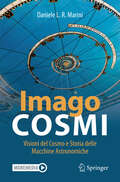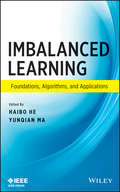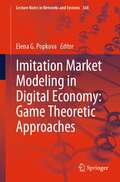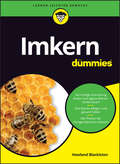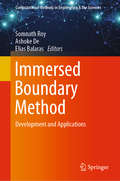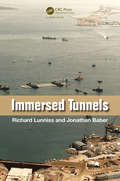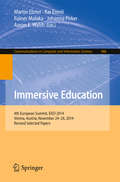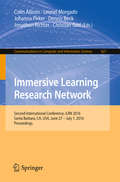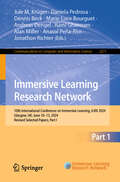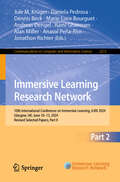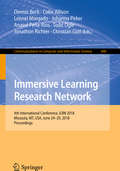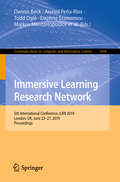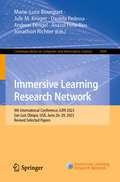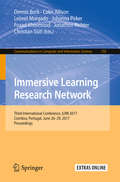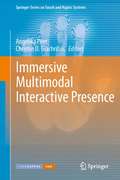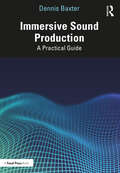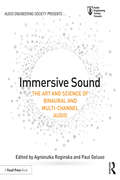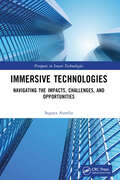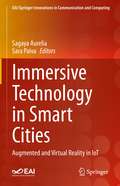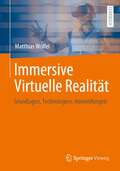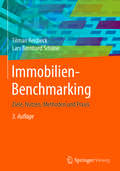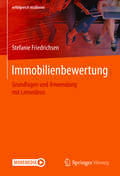- Table View
- List View
Imagining the Futures of Higher Education in Southern Africa: An Exploration from Multiple Perspectives (Future Education and Learning Spaces)
by Waaiza Udhin Vicky Avinash OojorahThis book showcases multiple perspectives about the futures of Higher Education from experts and other stakeholders in academia in the Southern African region, with each chapter presenting a different scenario of a possible future for Higher Education. It situates itself at the confluence of various fields of study such as Educational Technologies, Artificial Intelligence (AI), Sociology of Education, Sociology of the Future, Sustainable Development and Climate Change. It also includes various topics, such as digital development in terms of AI and emerging technologies, Higher Educational strategising and planning, the philosophical underpinnings of Higher Education and the present-day need for Sustainable Development models. Through the various chapters discussing the above-mentioned themes in the varied contexts of the Southern African region, this book helps readers engage in imaginative thinking regarding the future world and thus be prepared to embrace the challenges ahead. This book also underpins curriculum development for the new era firstly through new philosophical outlooks and secondly through ideas for novel learning areas in Higher Education and content to help shape minds for the twenty-first century. This book paves the way for innovation, progress and adaptation to the changing needs of the Higher Education clientele. It also attempts to influence policymaking, support advocates for sustainability and environmental education, prepare for technological advancements and improve the resilience and wellbeing of people in the region.
Imago Cosmi: The Vision of the Cosmos and the History of Astronomical Machines (Astronomers' Universe)
by Daniele L. MariniThis book takes the reader on an exploration of the Cosmos, from Mesopotamia and Egypt to China; it unveils the fascinating development of astronomy and mathematics. After an overview of the origins of these subjects, highlighting the contributions of Greek astronomers, the Arab culture, and Copernicus' solar system model, the book delves into the revolutionary work of Tycho Brahe, Johannes Kepler, Galileo Galilei, and Isaac Newton, leading to a comprehensive understanding of the solar system. Special attention is given to the instruments used by ancient astronomers, including the most important astronomical clocks and planetary machines. In light of this, the author examines Kepler's almost unknown design of a planetary machine and offers an interpretation using virtual reality techniques. The book also highlights the Chinese view of the Cosmos and the evolution of its astronomy and astronomical machines, offering readers a unique perspective and insight into the relationship between astronomy and technology in different cultures. Finally, the author provides a practical approach to understanding the construction and mechanics of astronomical machines, exploring the process of designing and manufacturing a Tellurium. The reading is enriched with short videos of the Tellurium, along with a translation of the description of the planetary machine by Christian Huygens. In addition, it provides a unique glimpse into the religious influences on astronomical studies during the mid-1700s through the translation of Johann Albrecht Bengel's book Cyclus. This book is a must-read for anyone interested in the history of science and technology. It appeals to astronomers, mathematicians, physicists, and historians of science and technology alike, providing fascinating descriptions and insightful analysis of the vision of the Cosmos from its earliest conceptions to the present day.
Imago Cosmi: Visioni del Cosmo e Storia delle Macchine Astronomiche
by Daniele L. MariniQuesto libro conduce il lettore in un viaggio esplorativo attraverso il Cosmo, dall'antica Mesopotamia ed Egitto fino alla Cina, svelando il fascino dello sviluppo dell'astronomia e della matematica che ha dato vita alla rivoluzione scientifica. Dopo una panoramica sulle origini di questi campi di studio, evidenziando i contributi degli astronomi greci, della cultura araba e del modello eliocentrico di Copernico, il testo si addentra nel lavoro rivoluzionario di Tycho Brahe, Johannes Kepler, Galileo Galilei e Isaac Newton, offrendo una comprensione approfondita del sistema solare. Gli strumenti utilizzati dagli astronomi, tra cui gli orologi astronomici e le macchine planetarie più significative, sono al centro dell'attenzione, consentendo di comprendere meglio la formazione e la diffusione della concezione del Sistema Solare. Inoltre, l'autore esamina il poco conosciuto progetto di una macchina planetaria di Kepler e ne offre un'interpretazione utilizzando tecniche di realtà virtuale. Il libro mette in luce anche la visione cinese del Cosmo e l'evoluzione della sua astronomia e delle relative macchine, offrendo ai lettori una prospettiva unitaria sulla concezione del cosmo e della tecnologia in Occidente e nell'Estremo Oriente. I dati degli ingranaggi e dei periodi planetari delle macchine esaminate nel testo sono raccolti tra gli annessi web del libo. L'esperienza di lettura è arricchita dalla traduzione della descrizione della macchina planetaria di Christian Huygens e dalla trattazione del progetto e della realizzazione di un Tellurium per comprendere la costruzione e la meccanica delle macchine astronomiche. Inoltre, viene offerta una visione unica sulle influenze religiose sugli studi astronomici del XVIII secolo attraverso la traduzione del libro Cyclus di Johann Albrecht Bengel. Breve materiale video sull'Antikythera, sul Tellurium dell'autore e su quello di Philip M. Hahn completa la documentazione. Questo libro è un must per chiunque sia interessato alla storia della scienza e della tecnologia, appassionando sia gli astronomi, i matematici e i fisici che gli storici della scienza e della tecnologia, fornendo descrizioni affascinanti e analisi illuminanti della visione del Cosmo dalle sue prime concezioni fino ai giorni nostri. Video e documenti disponibili tramite app: scarica gratuitamente l'app SN More Media, scansiona il link con il tasto play e accedi ai video e ai documenti direttamente sul tuo smartphone o tablet.
Imbalanced Learning: Foundations, Algorithms, and Applications
by Yunqian Ma Haibo HeThe first book of its kind to review the current status and future direction of the exciting new branch of machine learning/data mining called imbalanced learning Imbalanced learning focuses on how an intelligent system can learn when it is provided with imbalanced data. Solving imbalanced learning problems is critical in numerous data-intensive networked systems, including surveillance, security, Internet, finance, biomedical, defense, and more. Due to the inherent complex characteristics of imbalanced data sets, learning from such data requires new understandings, principles, algorithms, and tools to transform vast amounts of raw data efficiently into information and knowledge representation. The first comprehensive look at this new branch of machine learning, this book offers a critical review of the problem of imbalanced learning, covering the state of the art in techniques, principles, and real-world applications.
Imitation Market Modeling in Digital Economy: Game Theoretic Approaches (Lecture Notes in Networks and Systems #368)
by Elena G. PopkovaThis book includes the best studies on the results of the International Scientific and Practical Conference “New behaviors of market players in the digital economy,” which was held by the Institute of Scientific Communications on July 8, 2021, online, in YouTube format. This book is devoted to the study of digital economy markets from the standpoint of various market players—society (consumers), entrepreneurship, and the state—from the standpoint of various sciences—economic, managerial, social, and legal—which ensures the multidisciplinarity of the book. The uniqueness of the book lies in the application of a new scientific and methodological approach to the study of digital economy markets—simulation modeling. The advantages of a game-based scientific and methodological approach to reducing the uncertainty of economic processes and systems—a combination of quantitative and qualitative analytical methods, a systematic consideration of economic processes and systems from a socio-economic point of view—make it especially suitable for studying digital economy markets. The book identifies the impact of globalization and digitalization on the modern economy and industry markets. The trends and features of the use of advanced technologies in the digital economy markets are studied. The modern practices of business management and business integration in the digital economy are considered. The foundations of economic security and sustainable development of markets and enterprises in the digital economy are revealed. The book is suitable for scientists studying the markets of the digital economy, who will find in it scientific and methodological recommendations and developments on the application of game theory, as well as ready simulation models of the digital economy markets.
Imkern für Dummies (Für Dummies)
by Howland BlackistonSie möchten Ihre eigenen Bienen halten und selbst leckeren Honig produzieren? Kein Problem! "Imkern für Dummies" führt Sie Schritt für Schritt durch alle Phasen der Honigproduktion: von der Auswahl der richtigen Ausrüstung bis zur Ernte und Vermarktung Ihres eigenen Honigs. Sie erfahren alles, was Sie über die Biologie, Züchtung und Pflege Ihres Bienenvolkes wissen müssen, wie Sie Schädlinge bekämpfen und sich Ihren Bienen nähern, ohne gestochen zu werden. So können Sie vielleicht schon bald Ihren eigenen Honig genießen.
Immersed Boundary Method: Development and Applications (Computational Methods in Engineering & the Sciences)
by Ashoke De Somnath Roy Elias BalarasThis volume presents the emerging applications of immersed boundary (IB) methods in computational mechanics and complex CFD calculations. It discusses formulations of different IB implementations and also demonstrates applications of these methods in a wide range of problems. It will be of special value to researchers and engineers as well as graduate students working on immersed boundary methods, specifically on recent developments and applications. The book can also be used as a supplementary textbook in advanced courses in computational fluid dynamics.
Immersed Tunnels
by Richard Lunniss Jonathan BaberImmersed tunnels have been around for more than a century but remain a relatively unknown form of tunnel construction. For waterway crossings they are an effective alternative to bored tunnels and bridges, particularly in shallower waters, soft alluvial soils, and earthquake-prone areas. Successful implementation requires a thorough understanding o
Immersive Education
by Johanna Pirker Martin Ebner Kai Erenli Rainer Malaka Aaron E. WalshThis book constitutes the refereed proceedings of the 4th European Immersive Education Summit, EiED 2014, held in Vienna, Austria, in November 2014. The 11 revised full papers presented were carefully reviewed and selected from 30 submissions. The papers are organized in topical sections on innovation and technological advancements in e-learning; immersive and emerging technologies for cultural and digital heritage.
Immersive Learning Research Network
by Colin Allison Leonel Morgado Johanna Pirker Dennis Beck Jonathon Richter Christian GütlThis book constitutes the refereed proceedings of the Second International Conference of the Immersive Learning Network, iLRN 2016, held in Santa Barbara, CA, USA, in June/July 2016. The proceedings contain 9 full papers carefully reviewed and selected from 45 submissions and the best 5 special track papers. The papers focus on various applications of immersive technologies to learning.
Immersive Learning Research Network: 10th International Conference on Immersive Learning, iLRN 2024, Glasgow, UK, June 10–13, 2024, Revised Selected Papers, Part I (Communications in Computer and Information Science #2271)
by Dennis Beck Jonathon Richter Alan Miller Anasol Peña-Rios Andreas Dengel Rami Ghannam Marie-Luce Bourguet Jule M. Krüger Daniela PedrosaThis book constitutes the proceedings of the10th International Conference on Immersive Learning, iLRN 2024, held in Glasgow, UK during June 10–13, 2024. The 30 full papers and 13 short papers presented in this volume were carefully reviewed and selected from 144 submissions. They were categorized under the topical section as follows: Part I: Foundations in Immersive Learning Research and Theory; Assessment and Evaluation (A&E); Galleries, Libraries, Archives and Museums (GLAM); Inclusion, Diversity, Equity, Access, and Social Justice (IDEAS); STEM Education (STEM); Medical & Healthcare Education (MHE); Workforce Development & Industry Training (WDIT); Self and Co-regulated Learning with Immersive Learning Environments (SCILE). Part II: Special Track 1: Immersive learning across Latin America: State of Research, Use Cases and Projects; Special Track 2: Sustainable Development and Immerse Learning in the Climate Emergency; Special Track 3: Literacy Equity and Immersive Learning.
Immersive Learning Research Network: 10th International Conference on Immersive Learning, iLRN 2024, Glasgow, UK, June 10–13, 2024, Revised Selected Papers, Part II (Communications in Computer and Information Science #2272)
by Dennis Beck Jonathon Richter Alan Miller Anasol Peña-Rios Andreas Dengel Rami Ghannam Marie-Luce Bourguet Jule M. Krüger Daniela PedrosaThis book constitutes the proceedings of the10th International Conference on Immersive Learning, iLRN 2024, held in Glasgow, UK during June 10–13, 2024. The 30 full papers and 13 short papers presented in this volume were carefully reviewed and selected from 144 submissions. They were categorized under the topical section as follows: Part I: Foundations in Immersive Learning Research and Theory; Assessment and Evaluation (A&E); Galleries, Libraries, Archives and Museums (GLAM); Inclusion, Diversity, Equity, Access, and Social Justice (IDEAS); STEM Education (STEM); Medical & Healthcare Education (MHE); Workforce Development & Industry Training (WDIT); Self and Co-regulated Learning with Immersive Learning Environments (SCILE). Part II: Special Track 1: Immersive learning across Latin America: State of Research, Use Cases and Projects; Special Track 2: Sustainable Development and Immerse Learning in the Climate Emergency; Special Track 3: Literacy Equity and Immersive Learning.
Immersive Learning Research Network: 11th International Conference, iLRN 2025, Chicago, IL, USA, June 15–19, 2025, Revised Selected Papers (Communications in Computer and Information Science #2598)
by Dennis Beck Jonathon Richter Anasol Peña-Rios Matthew Schmidt Anastasios Mikropoulos Genevieve Smith-Nunes Jule M. Krüger Daniela Pedrosa George Koutromanos Stylianos MystakidisThis book constitutes the revised selected papers of the 11th International Conference on Immersive Learning, iLRN 2025, held in Chicago, IL, USA, during June 15–19, 2025. The 23 full papers presented in this volume were carefully reviewed and selected from 57 submissions. They were categorized under the topical sections as follows: Foundations in Immersive Learning Research and Theory; Assessment and Evaluation (A&E); Inclusion, Diversity, Equity, Access, and Social Justice (IDEAS); STEM Education (STEM); Medical & Healthcare Education (MHE); Workforce Development & Industry Training (WDIT); Self and Co-regulated Learning with Immersive Learning Environments (SCILE); Special Track 1: Immersive learning across Latin America: State of Research, Use Cases and Projects; Special Track 2: Navigating Grand Challenges: Immersive Learning & Global Solutions (iLRNGrandChallenges); and Special Track 3: Sustainable Development and Immerse Learning in the Climate Emergency.
Immersive Learning Research Network: 4th International Conference, iLRN 2018, Missoula, MT, USA, June 24-29, 2018, Proceedings (Communications in Computer and Information Science #840)
by Colin Allison Leonel Morgado Johanna Pirker Dennis Beck Jonathon Richter Christian Gütl Anasol Peña-Rios Todd OgleThis volume constitutes the refereed proceedings of the 4th International Conference of the Immersive Learning Network, iLRN 2018, held in Missoula, MT, USA, in June 2018. The 12 revised full papers and the two revised short papers presented in this volume were carefully reviewed and selected from 57 submissions. The papers are organized in topical sections on environmental sciences, climate change, immersive technologies; immersive technologies in cultural heritage; immersive technologies in primary and secondary education; games and game design.
Immersive Learning Research Network: 5th International Conference, iLRN 2019, London, UK, June 23–27, 2019, Proceedings (Communications in Computer and Information Science #1044)
by Leonel Morgado Johanna Pirker Dennis Beck Jonathon Richter Christian Gütl Anasol Peña-Rios Todd Ogle Daphne Economou Markos Mentzelopoulos Christian Eckhardt Roxane Koitz-Hristov Michael GardnerThis volume constitutes the refereed proceedings of the 5th International Conference of the Immersive Learning Network, iLRN 2019, held in London, UK, in June 2019.The 18 revised full papers and presented in this volume were carefully reviewed and selected from 60 submissions. The papers are organized in topical sections on science, technology, engineering, and mathematics (STEM); disciplinary applications: special education; disciplinary applications: history; pedagogical strategies; immersion and presence.
Immersive Learning Research Network: 9th International Conference, iLRN 2023, San Luis Obispo, USA, June 26–29, 2023, Revised Selected Papers (Communications in Computer and Information Science #1904)
by Jonathon Richter Anasol Peña-Rios Andreas Dengel Marie-Luce Bourguet Jule M. Krüger Daniela PedrosaThis volume constitutes the refereed proceedings of the 9th International Conference of the Immersive Learning Network, iLRN 2023, held in San Luis Obispo, USA, in June 2023 as a hybrid event.The 26 revised full papers and 13 shprt papers presented in this volume were carefully reviewed and selected from 110 submissions. The papers are organized in topical sections on foundations in immersive learning research and theory; assessment and evaluation; galleries, libraries, archives and museums; inclusion, diversity, equity, access, and social justice; STEM education; language, culture and heritage; nature & environmental sciences; workforce development & industry training; self and co-regulated learning with immersive learning environments; special track: immersive learning across Latin America: state of research, use cases and projects.
Immersive Learning Research Network: Third International Conference, iLRN 2017, Coimbra, Portugal, June 26–29, 2017. Proceedings (Communications in Computer and Information Science #725)
by Colin Allison Leonel Morgado Johanna Pirker Dennis Beck Jonathon Richter Christian Gütl Foaad KhosmoodThis book constitutes the refereed proceedings of the Second International Conference of the Immersive Learning Network, iLRN 2016, held in Santa Barbara, CA, USA, in June/July 2016. The proceedings contain 9 full papers carefully reviewed and selected from 45 submissions and the best 5 special track papers. The papers focus on various applications of immersive technologies to learning.
Immersive Multimodal Interactive Presence
by Angelika Peer Christos D. GiachritsisImmersive Multimodal Interactive Presence presents advanced interdisciplinary approaches that connect psychophysical and behavioral haptics research with advances in haptic technology and haptic rendering. It delivers a summary of the results achieved in the IMMERSENCE European project and includes selected chapters by international researchers. Organized into two parts: I. Psychophysical and Behavioral Basis and II. Technology and Rendering, it is an excellent example of interdisciplinary research directed towards the advancement of multimodal immersive virtual environments with particular focus on haptic interaction. The twelve chapters of the book are grouped around three different scenarios representing different types of interactions in virtual environments: Person-Object (PO), Person-Object-Person (POP) and Person-Person (PP) interaction. Recent results of psychophysical and behavioral studies are reported along with new technological developments for haptic displays and novel haptic rendering techniques.
Immersive Sound Production: A Practical Guide
by Dennis BaxterImmersive Sound Production is a handbook for the successful implementation of immersive sound for live sports and entertainment. This book presents thorough explanations of production practices and possibilities and takes the reader through the essentials of immersive sound capture and creation with real world examples of microphones, mixing and mastering practices. Additionally, this book examines the technology that makes immersive sound possible for the audio mixer, sound designer and content producer to craft a compelling soundscape. This book serves as a guide for all audio professionals, from aspiring audio mixers to sound designers and content producers, as well as students in the areas of sound engineering, TV and broadcast and film.
Immersive Sound: The Art and Science of Binaural and Multi-Channel Audio (Audio Engineering Society Presents)
by Agnieszka Roginska Paul GelusoImmersive Sound: The Art and Science of Binaural and Multi-Channel Audio provides a comprehensive guide to multi-channel sound. With contributions from leading recording engineers, researchers, and industry experts, Immersive Sound includes an in-depth description of the physics and psychoacoustics of spatial audio as well as practical applications. Chapters include the history of 3D sound, binaural reproduction over headphones and loudspeakers, stereo, surround sound, height channels, object-based audio, soundfield (ambisonics), wavefield synthesis, and multi-channel mixing techniques. Knowledge of the development, theory, and practice of spatial and multi-channel sound is essential to those advancing the research and applications in the rapidly evolving fields of 3D sound recording, augmented and virtual reality, gaming, film sound, music production, and post-production.
Immersive Technologies: Navigating the Impacts, Challenges, and Opportunities (Prospects in Smart Technologies)
by Sagaya AureliaImmersive technology is going to govern the next generation in terms of education, health, military, tourism, and much more. Through its comprehensive exploration, didactic approach, and insightful analyses, this book provides an invaluable resource for understanding and harnessing the power of immersive technology.Immersive Technologies: Navigating the Impacts, Challenges, and Opportunities serves as a guiding compass through the immersive technology landscape and takes a multifaceted approach, addressing both the technical and human aspects. The book dissects the underlying methods and technologies that power immersive experiences, offering readers a clear understanding of how VR, AR, and MR function. The latest advancements, from cutting-edge hardware developments to revolutionary software applications are discussed in detail. The book also delves into the potential societal impacts and takes the reader on a journey from education to healthcare, entertainment to remote collaboration, so the reader can gain insights into the myriad of ways immersive technology is already shaping industries and human interaction. The ultimate benefit readers will derive from this book is a holistic grasp of the immersive technology landscape and they will be armed with knowledge about the challenges and opportunities presented by VR, AR, and MR. They will be well-equipped to navigate the future.This is a must-read for anyone interested in how this technology has the potential to reshape our world. Academicians will be enriched with the applications and practical perspectives.
Immersive Technology in Smart Cities: Augmented and Virtual Reality in IoT (EAI/Springer Innovations in Communication and Computing)
by Sara Paiva Sagaya AureliaThis book presents recent trends and enhancements in the convergence of immersive technology and smart cities. The authors discuss various domains such as medical education, construction, brain interface, interactive storytelling, edification, and journalism in relation to combining smart cities, IoT and immersive technologies. The book sets up a medium to promulgate insights and in depth understanding among experts in immersive technologies, IoT, HCI and associated establishments. The book also includes case studies, survey, models, algorithms, frameworks and implementations in storytelling, smart museum, medical education, journalism and more. Various practitioners, academicians and researchers in the domain contribute to the book.
Immersive Virtuelle Realität: Grundlagen, Technologien, Anwendungen
by Matthias WölfelVollständig realistische Erfahrungen in einer virtuellen Welt anbieten: Darum geht es bei Immersiver Virtueller Realität. Das ausführliche Lehrbuch bietet Studierenden der Informatik, Medien-, Ingenieur- oder Sozialwissenschaften sowie Medienschaffenden und Anwendern immersiver Umgebungen ein anschauliches Nachschlagewerk zu einschlägigen Lehrveranstaltungen oder zum Selbststudium. Dabei adressiert das Buch alle Aspekte immersiver Medien, die für ein ganzheitliches Verständnis relevant sind: Die ersten Kapitel führen in die theoretischen Grundlagen ein. Diese behandeln die verschiedenen Ausprägungender Realität sowie das Metaversum als Zukunftsvision des Internets, geben einen historischen Überblick, beschreiben relevante Sinne und setzen sich mit Interaktion, Interface und Fortbewegung auseinander. Die darauffolgenden Kapitel veranschaulichen die zugrundeliegenden Technologien wie Sensorik, Tracking und Ausgabetechniken einschließlich Stereoskopie und kopfbezogener Übertragungsfunktion. Der letzte Teil des Buches gibt praxisnahe Einblicke in die unterschiedlichen Anwendungsbereiche: Unterhaltung, soziale Interaktion, Lehren und Lernen, Entwicklung sowie soziologische und medientheoretische Forschung.
Immobilien-Benchmarking: Ziele, Nutzen, Methoden und Praxis
by Lars Bernhard Schöne Tilman ReisbeckImmobilien-Benchmarking ist insbesondere zur Renditeoptimierung und Kostensenkung nützlich. Das Immobilienmanagement und dessen integrale Betrachtung innerhalb des Immobilienlebenszyklus unter Verwendung des Immobilien-Benchmarking werden in diesem Buch dargestellt und analysiert. Dabei wird auch auf die dafür erforderlichen Grundlagen eingegangen und in einzelnen Bausteinen in die Thematik eingeführt. Vor dem Hintergrund der umfangreichen Praxiserfahrungen der Autoren wird eine bewährte und zielführende Vorgehensweise bei Benchmarking-Projekten vorgestellt. Beispiele sowohl aus dem öffentlichen Bereich als auch aus der Industrie belegen die Praxistauglichkeit der vorgestellten Grundlagen und Vorgehensweisen. Das Werk schließt mit einer Zusammenfassung, einer kritischen Beurteilung und einem Ausblick der Autoren für die weitere Entwicklung im Immobilien-Benchmarking.
Immobilienbewertung: Grundlagen und Anwendung mit Lernvideos (erfolgreich studieren)
by Stefanie FriedrichsenDieses Lehrbuch führt in die Grundlagen der Immobilienbewertung ein. Studierende lernen sowohl die normierten Verfahren nach Immobilienwertermittlungsverordnung (ImmoWertV) als auch zwei sog. nicht normierte Verfahren zur Wertermittlung kennen.23 Kurzvideos zum Vorgehen bei den einzelnen Methoden der Wertermittlung und Beispielrechnungen veranschaulichen den Lehrstoff und unterstützen beim Lernen.Das Lehrbuch ist in der Springer Vieweg Reihe "erfolgreich studieren" erschienen.


